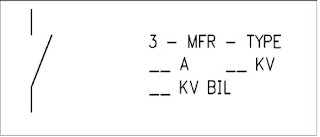Substation Air Switch
Substation air switches are mechanical switching device that are used for changing the
connections in a circuit. The switches are required to carry normal load current
continuously and short-circuit current for short period of time. Substation air switches
are used for circuit breaker isolation, power transformer isolation, electrical equipment
bypassing, and bus sectionalizing.
Figure 3-5, 3-6, 3-7, and 3-8 shows different type of
outdoor air switches.
Figure 3-5: Hook Stick-Operated Disconnecting Switch
Figure 3-6: Three-Phase Gang-Operated Disconnecting Switch with Horn Gaps and Grounding Switch
Figure 3-7: Three-Phase Double Side-Break Disconnecting Switch with Motor Operator
Figure 3-8: Fused Disconnect
The operating mechanisms are bonded directly to the operator mat/platform with a 4/0
copper ground conductor to ensure that the operating personnel’s hands and feet will be
maintained at the same potential. Figure 5-22 and 5-23 shows horizontally mounted
double break switch with grounding and horizontally mounted double break switch.
Figure 5-22: Horizontally Mounted Figure Double Break Switch with Break Switch
5-23: Horizontally Mounted Double
Grounding Switch
Table 4-8 lists the phase spacing of various types of outdoor air switches.
The minimum metal-to-metal clearances should be maintained at all times with the switches
in the open, closed, or anywhere between the open and closed positions.
Table 4-8: Phase Spacing of Outdoor Air Switches






